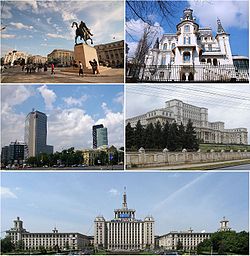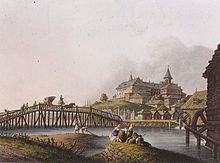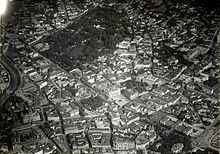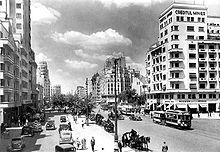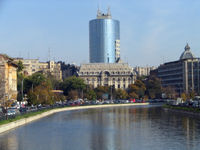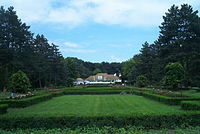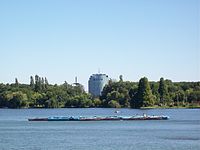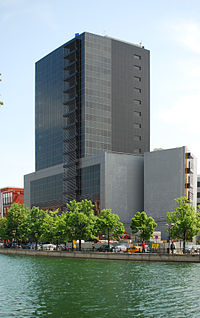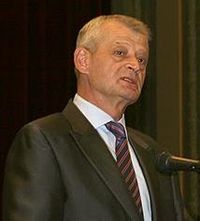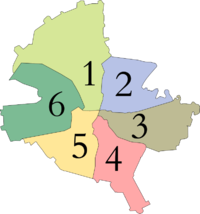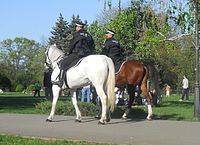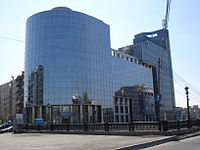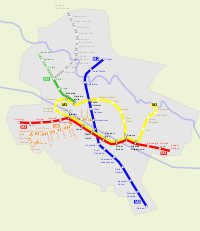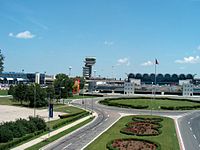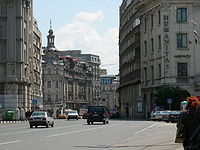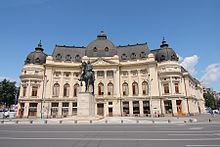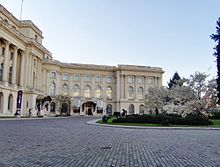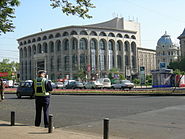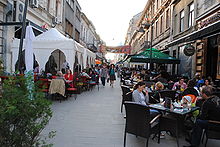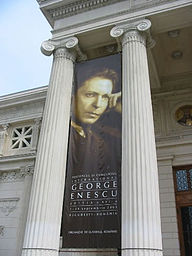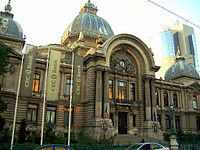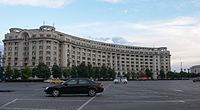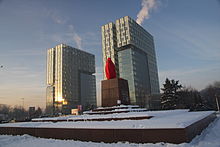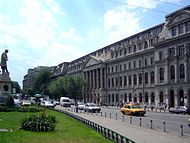- Bucharest
-
"Bukarest" redirects here. For the Deutsche Levant Line ship, see MV Bukarest.
Bucharest
Bucureşti (Romanian)— Municipality — Clockwise from top left: Revolution Square (Piaţa Revoluţiei) • Creţulescu Palace (Palatul Creţulescu) • Palace of the Parliament (Palatul Parlamentului) • The House of the Free Press (Casa Presei Libere) • Victory Square (Piaţa Victoriei) 
Flag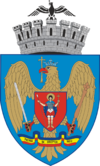
Coat of armsNickname(s): Paris of the East, Little Paris[1] Location in Romania Coordinates: 44°25′57″N 26°6′14″E / 44.4325°N 26.10389°E Country Romania County None1 First attested 1459 Government – Mayor Sorin Oprescu (Independent) Area[2][3] – Municipality 228 km2 (88 sq mi) – Urban 285 km2 (110 sq mi) – Metro 5,046.1 km2 (1,948.3 sq mi) Elevation 55.8–91.5 m (183.1–300.2 ft) Population (est. July 1, 2010)[2][4][5] – Municipality 1,942,254 – Rank 1st in Romania
6th in the European Union– Density 8,510/km2 (22,040.8/sq mi) – Urban 2,192,372 – Metro 2,330,000 Time zone EET (UTC+2) – Summer (DST) EEST (UTC+3) Postal Code 0xxxxx Area code(s) +40 x1 Car plate B Website Official site 1Romanian law stipulates that Bucharest has a special administrative status which is equal to that of a county. Bucharest (Romanian: București pronounced [bukuˈreʃtʲ] (
 listen)) is the capital municipality, cultural, industrial, and financial centre of Romania. It is the largest city in Romania, located in the southeast of the country, at 44°25′57″N 26°06′14″E / 44.4325°N 26.10389°ECoordinates: 44°25′57″N 26°06′14″E / 44.4325°N 26.10389°E, and lies on the banks of the Dâmbovița River.
listen)) is the capital municipality, cultural, industrial, and financial centre of Romania. It is the largest city in Romania, located in the southeast of the country, at 44°25′57″N 26°06′14″E / 44.4325°N 26.10389°ECoordinates: 44°25′57″N 26°06′14″E / 44.4325°N 26.10389°E, and lies on the banks of the Dâmbovița River.Bucharest was first mentioned in documents as early as 1459. Since then it has gone through a variety of changes, becoming the state capital of Romania in 1862 and steadily consolidating its position as the centre of the Romanian mass media, culture and arts. Its eclectic architecture is a mix of historical (neo-classical), interbellum (Bauhaus and Art Deco), Communist-era and modern. In the period between the two World Wars, the city's elegant architecture and the sophistication of its elite earned Bucharest the nickname of "Little Paris" (Micul Paris).[6] Although many buildings and districts in the historic centre were damaged or destroyed by war, earthquakes, and Nicolae Ceaușescu's program of systematization, many survived. In recent years, the city has been experiencing an economic and cultural boom.[7]
According to 1 July 2010 official estimates, Bucharest proper has a population of 1,942,254.[2] The urban area extends beyond the limits of Bucharest proper and has a population of 2 million people.[3][8] Adding the satellite towns around the urban area, the proposed metropolitan area of Bucharest would have a population of 2.33 million people.[5] According to unofficial data, the population is more than 3 million.[9] Bucharest is the 6th largest city in the European Union by population within city limits.[10]
Economically, Bucharest is the most prosperous city in Romania[11] and is one of the main industrial centres and transportation hubs of Eastern Europe. The city has a broad range of convention facilities, educational facilities, cultural venues, shopping arcades, and recreational areas.
The city proper is administratively known as the Municipality of Bucharest (Municipiul București), and has the same administrative level as a county, being further subdivided into six sectors.
Contents
Etymology
The name of Bucur has an uncertain origin: tradition connects the founding of Bucharest with the name of Bucur who was either a prince, an outlaw, a fisherman, a shepherd, or a hunter, according to different legends.[12] In Romanian the word stem bucur means 'glad', 'joy'.
The official city name in full is The Municipality of Bucharest (Romanian: Municipiul București).
A native or resident of Bucharest is called a Bucharester (Romanian: bucureștean).
History
Bucharest's history alternated periods of development and decline from the early settlements of the Antiquity and until its consolidation as capital of Romania late in the 19th century.
First mentioned as the "Citadel of București" in 1459, it became a residence of the Wallachian prince Vlad III the Impaler. The Old Princely Court (Curtea Veche) was built by Mircea Ciobanul, and under subsequent rulers, Bucharest was established as the summer residence of the court, competing with Târgoviște for the status of capital after an increase in the importance of southern Muntenia brought about by the demands of the suzerain power, the Ottoman Empire.
Burned down by the Ottomans and briefly discarded by princes at the start of the 17th century, Bucharest was rebuilt and continued to grow in size and prosperity. Its centre was developed around the Ulița Mare (lit. Grand Street), which starting with 1589 became known as Lipscani. Before the 18th century, it became the most important trade centre of Wallachia and became a permanent location for the Wallachian court after 1698 (starting with the reign of Constantin Brâncoveanu).
Partly destroyed by natural disasters and rebuilt several times during the following 200 years[clarification needed], and hit by Caragea's plague in 1813–1814, the city was wrested from Ottoman control and occupied at several intervals by the Habsburg Monarchy (1716, 1737, 1789) and Imperial Russia (three times between 1768 and 1806). It was placed under Russian administration between 1828 and the Crimean War, with an interlude during the Bucharest-centred 1848 Wallachian revolution, and an Austrian garrison took possession after the Russian departure (remaining in the city until March 1857). Additionally, on 23 March 1847, a fire consumed about 2,000 buildings, destroying a third of the city.
In 1861, when Wallachia and Moldavia were united to form the Principality of Romania, Bucharest became the new nation's capital; in 1881, it became the political centre of the newly-proclaimed Kingdom of Romania under Carol I. During the second half of the 19th century, due to its new status, the city's population increased dramatically, and a new period of urban development began. During this period, gas lighting, horse-drawn trams and limited electrification were introduced.[13] The Dâmboviţa was also chanelled in 1883, thus putting a stop tgo previously endemic floods.[14] The extravagant architecture and cosmopolitan high culture of this period won Bucharest the nickname of "The Paris of the East" (or "Little Paris", Micul Paris), with Calea Victoriei as its Champs-Élysées.
Between 6 December 1916 and November 1918, the city was occupied by German forces as a result of the Battle of Bucharest, with the legitimate capital temporarily moved to Iași. After World War I, Bucharest became the capital of Greater Romania. The interwar years saw continued development, with the city gaining an average of 30,000 new residents each year. Also, some of the city's main landmarks were built in this period, including Arcul de Triumf and Palatul Telefoanelor.[15] However, the Great Depression took its toll on Bucharest's citizens, culminating in the Griviţa Strike of 1933.[16]
In January 1941, the city was the scene of the Legionnaires' rebellion and Bucharest pogrom. As the capital of an Axis country and a major transit point for Axis troops en route to the Eastern Front, Bucharest suffered heavy damage during World War II due to Allied bombings, and, on 23 August 1944, was the site of the royal coup which brought Romania into the Allied camp, suffering a short period of Luftwaffe bombings as well as a failed attempt by German troops to take the city by force.
After the establishment of communism in Romania, the city continued growing. New districts were constructed, most of them dominated by tower blocks. During Nicolae Ceaușescu's leadership (1965–1989), much of the historic part of the city was demolished and replaced with Socialist realist development such as the Centrul Civic (the Civic Centre), including the Palace of the Parliament, where an entire historic quarter was razed to make way for Ceaușescu's megalomaniac constructions. On 4 March 1977, an earthquake centered in Vrancea, about 135 km (83.89 mi) away, claimed 1,500 lives and caused further damage to the historic centre.
The Romanian Revolution of 1989 began with mass anti-Ceaușescu protests in Timișoara in December 1989 and continued in Bucharest, leading to the overthrow of the Communist regime. Dissatisfied with the post-revolutionary leadership of the National Salvation Front, student leagues and opposition groups organized large-scale protests continued in 1990 (the Golaniad), which were violently stopped by the miners of Valea Jiului (the Mineriad). Several other Mineriads followed, the results of which included a government change.
After the year 2000, due to the advent of significant economic growth in Romania, the city has modernized and is currently undergoing a period of urban renewal. Various residential and commercial developments are underway, particularly in the northern districts, while Bucharest's historic centre is currently undergoing restoration.
Treaties signed in Bucharest
- Treaty of 28 May 1812, at the end of the Russo-Turkish War
- Treaty of 3 March 1886, at the end of the Serbo-Bulgarian War
- Treaty of 10 August 1913, at the end of the Second Balkan War
- Treaty of 4 August 1916, the treaty of alliance between Romania and the Entente
- Treaty of 6 May 1918, the treaty between Romania and the Central Powers
Geography
General information
Bucharest is situated on the banks of the Dâmbovița River, which flows into the Argeș River, a tributary of the Danube. Several lakes – the most important of which are Lake Herăstrău, Lake Floreasca, Lake Tei, and Lake Colentina – stretch across the northern parts of the city, along the Colentina River, a tributary of the Dâmbovița. In addition, in the centre of the capital there is a small artificial lake – Lake Cișmigiu – surrounded by the Cișmigiu Gardens. The Cișmigiu Gardens have a rich history, being frequented by famous poets and writers. Opened in 1847 and based on the plans of German architect Carl F.W. Meyer, the gardens are currently the main recreational facility in the city centre.
Besides Cișmigiu, Bucharest contains several other large parks and gardens, including Herăstrău Park and the Botanical Garden. Herăstrău is located in the north of the city, around Lake Herăstrău, and is the site of the Village Museum, while the Botanical Garden is the largest of its kind in Romania and contains over 10,000 species of plants, many of them exotic; it was once a pleasure park for the royal family.[17]
Bucharest is situated in the south eastern corner of the Romanian Plain, in an area once covered by the Vlăsiei forest, which, after it was cleared, gave way to a fertile flatland. As with many cities, Bucharest is traditionally considered to have seven hills, similar to the seven hills of Rome. Bucharest's seven hills are: Mihai Vodă, Dealul Mitropoliei, Radu Vodă, Cotroceni, Spirei, Văcărești and Sf. Gheorghe Nou.
The city has a total area of 226 square kilometres (87 sq mi). The altitude varies from 55.8 metres (183.1 ft) at the Dâmbovița bridge in Cățelu, south-eastern Bucharest and 91.5 m (300.2 ft) at the Militari church. The city has a relatively round shape, with the centre situated approximately in the cross-way of the main north-south/east-west axes at University Square. The milestone for Romania's Kilometre Zero is placed just south of University Square in front of the New St. George Church (Sfântul Gheorghe Nou) at St. George Square (Piaţa Sfântul Gheorghe). Bucharest's radius, from University Square to the city limits in all directions, varies from about 10 to 12 km (6.25–7.5 mi).
Until recently, the regions surrounding Bucharest were largely rural, but after 1989, new suburbs started to be built around Bucharest, in the surrounding Ilfov county. Further urban consolidation is expected to take place in the late 2010s, when the Bucharest metropolitan area will become operational, incorporating various communes and cities of Ilfov and other surrounding counties.[18]
Climate
Bucharest has a humid continental climate (Köppen climate classification Dfa). Due to its position on the Romanian Plain, the city's winters can get windy, even though some of the winds are mitigated due to urbanisation. Winter temperatures often dip below 0 °C (32 °F), sometimes even dropping to −20 °C (−4 °F). In summer, the average temperature is approximately 23 °C (73 °F) (the average for July and August), despite the fact that temperatures frequently reach 35 °C (95 °F) to 40 °C (104 °F) in mid-summer in the city centre. Although average precipitation and humidity during summer are low, there are occasional heavy storms. During spring and autumn, average daytime temperatures vary between 17 °C (63 °F) to 22 °C (72 °F), and precipitation during this time tends to be higher than in summer, with more frequent yet milder periods of rain.
Climate data for Bucharest Month Jan Feb Mar Apr May Jun Jul Aug Sep Oct Nov Dec Year Record high °C (°F) 16
(61)22
(72)29
(84)32
(90)37
(99)43
(109)41
(106)41
(106)39
(102)35
(95)26
(79)20
(68)43
(109)Average high °C (°F) 1.5
(34.7)4.1
(39.4)10.5
(50.9)18
(64)23.3
(73.9)26.8
(80.2)28.8
(83.8)28.5
(83.3)24.6
(76.3)18
(64)10
(50)3.8
(38.8)16.5 Average low °C (°F) −5.5
(22.1)−3.3
(26.1)0.3
(32.5)5.6
(42.1)10.5
(50.9)14
(57)15.6
(60.1)15
(59)11.1
(52.0)5.7
(42.3)1.6
(34.9)−2.6
(27.3)5.7 Record low °C (°F) −32
(−26)−26
(−15)−19
(−2)−4
(25)0
(32)5
(41)8
(46)7
(45)0
(32)−6
(21)−14
(7)−23
(−9)−32
(−26)Precipitation mm (inches) 40
(1.57)36
(1.42)38
(1.5)46
(1.81)70
(2.76)77
(3.03)64
(2.52)58
(2.28)42
(1.65)32
(1.26)49
(1.93)43
(1.69)595
(23.43)% humidity 87 84 73 63 63 62 58 59 63 73 85 89 72 Avg. precipitation days 6 6 6 7 6 6 7 6 5 5 6 6 72 Avg. snowy days 6 3 4 0 0 0 0 0 0 0 2 4 19 Sunshine hours 61 85 155 180 248 270 341 310 240 155 60 62 2,167 Source: World Meteorological Organisation[19] Law and government
Administration
Bucharest has a unique status in Romanian administration, since it is the only municipality that is not part of a county. Its population, however, is larger than that of any Romanian county, and hence the power of the Bucharest General City Hall (Primăria Generală), which is the city's local government body, is about the same as, if not greater than, that of Romanian county councils.
The city government is headed by a General Mayor (Primar General), currently (as of 2010) Sorin Oprescu. Decisions are approved and discussed by the General Council (Consiliu General) made up of 55 elected councilors. Furthermore, the city is divided into six administrative sectors (sectoare), each of which has their own 27-seat sectoral council, town hall and mayor. The powers of local government over a certain area are therefore shared by the Bucharest City Hall and the local sectoral councils with little or no overlapping of authority. The general rule is that the main City Hall is responsible for citywide utilities such as the water system, the transport system and the main boulevards, while sector halls manage the contact between individuals and the local government, secondary streets, parks, schools and cleaning services.
The six sectors are numbered from one to six and are disposed radially so that each one has under its administration an area of the city centre. They are numbered clockwise and are further divided into neighborhoods (cartiere), which are not an official administrative division:
- Sector 1 (population 227,717): Dorobanți, Băneasa, Aviației, Pipera, Aviatorilor, Primăverii, Romană, Victoriei, Herăstrău Park, Bucureștii Noi, Dămăroaia, Strǎulești, Grivița, 1 Mai, Băneasa Forest, Pajura, Domenii
- Sector 2 (population 357,338): Pantelimon, Colentina, Iancului, Tei, Floreasca, Moşilor, Obor, Vatra Luminoasă, Fundeni, Plumbuita, Ștefan cel Mare, Baicului
- Sector 3 (population 399,231): Vitan, Dudești, Titan, Centrul Civic, Dristor, Lipscani, Muncii, Unirii
- Sector 4 (population 300,331): Berceni, Olteniței, Giurgiului, Progresul, Văcărești, Timpuri Noi, Tineretului
- Sector 5 (population 288,690): Rahova, Ferentari, Giurgiului, Cotroceni, 13 Septembrie, Dealul Spirii
- Sector 6 (population 371,060): Giulești, Crângași, Drumul Taberei, Militari, Grozǎvești (also known as Regie), Ghencea
Like all other local councils in Romania, the Bucharest sectoral councils, the city's General Council and the mayors are elected every four years by the population. Additionally, Bucharest has a prefect, who is appointed by Romania's central government. The prefect is not allowed to be a member of a political party. The prefect's role is to represent the national government at local level, acting as a liaison and facilitating the implementation of National Development Plans and governing programs at local level. The current prefect of Bucharest (as of 2010) is Mihai Cristian Atanasoaiei.
The Municipality of Bucharest, along with the surrounding Ilfov county, forms the Bucharest development region, which is equivalent to NUTS-II regions in the European Union and is used by the European Union and the Romanian Government for statistical analysis and regional development. The Bucharest development region is not, however, an administrative entity.
Justice system
Bucharest's judicial system is similar to that of the Romanian counties. Each of the six sectors has its own local first instance court (judecătorie), while appeals from these courts' verdicts, and more serious cases, are directed to the Bucharest Tribunal, the city's municipal court. The Bucharest Court of Appeal judges appeals against decisions taken by tribunals in Bucharest and in five surrounding counties (Teleorman, Ialomiţa, Giurgiu, Călăraşi and Ilfov). Bucharest is also home to Romania's supreme court, the High Court of Cassation and Justice, as well as to the Constitutional Court of Romania.
Bucharest has its own municipal police force, the Bucharest Police (Poliția București), which is responsible for policing of crime within the whole city, and operates a number of special divisions. The Bucharest Police are headquartered on Ştefan cel Mare Blvd. in the city centre, and has a number of precincts throughout the city. From 2004 onwards, each Sector City Hall also has under its administration a Community Police force (Poliția Comunitară), dealing with local community issues. Bucharest also houses the General Inspectorates of the Gendarmerie and the National Police.
Crime
Bucharest's crime rate is rather low in comparison to other European capital cities, with the number of total offenses declining by 51% between 2000 and 2004.[20] The violent crime rate in Bucharest remains very low, with 11 murders and 983 other violent offenses taking place in 2007.[21] Although in the 2000s there have been a number of police crackdowns on organized crime gangs, such as the Cămătaru clan, organized crime generally has little impact on public life. Petty crime, however, is more common, particularly in the form of pickpocketing, which occurs mainly on the city's public transport network. Confidence tricks were common in the 1990s, especially in regards to tourists, but the frequency of these incidents has since declined. Levels of crime are higher in the southern districts of the city, particularly in Ferentari, a socially-disadvantaged area.
Although the presence of street children was a problem in Bucharest in the 1990s, their numbers have declined significantly in recent years, currently lying at or below the average of major European capital cities.[22] A documentary called Children Underground depicted the life of Romanian street kids in 2001. There are still an estimated 1,000 street children in the city,[22] some of whom engage in petty crime and begging.
Quality of life
As stated by the Mercer international surveys for quality of life in cities around the world, Bucharest occupied the 94th place in 2001[23] and slipped lower, to the 108th place in 2009 and the 107th place in 2010. Compared to it, Vienna occupied No. 1 worldwide in 2011 and 2009.[24] Budapest ranked 73rd (2010) and Sofia 114th (2010).[25] Mercer Human Resource Consulting issues yearly a global ranking of the world's most livable cities based on 39 key quality-of-life issues. Among them: political stability, currency-exchange regulations, political and media censorship, school quality, housing, the environment, public safety. Mercer collects data worldwide, in 215 cities. The difficult situation of the quality of life in Bucharest is confirmed also by a vast urbanism study, done by the Ion Mincu University of Architecture and Urbanism.[26]
Demographics
Historical populations Year Pop. ±% 1789 30,030 — 1831 60,587 +101.8% 1877 177,646 +193.2% 1930 639,040 +259.7% 1948 1,025,180 +60.4% 1956 1,177,661 +14.9% 1966 1,366,684 +16.1% 1977 1,807,239 +32.2% 1992 2,067,545 +14.4% 2002 1,926,334 −6.8% 2004 1,927,559 +0.1% 2008 1,942,254 +0.8% The city's population, according to the 2002 census, is 1,926,334 inhabitants,[27] or 8.9% of the total population of Romania. A significant number of people (possibly hundreds of thousands) commute to the city every day, mostly from the surrounding Ilfov county, however official statistics regarding their numbers do not exist.[28]
Bucharest's population experienced two phases of rapid growth, the first beginning in the late 19th century when the city was consolidated as the national capital and lasting until the Second World War, and the second during the Ceauşescu years (1965–1989), when a massive urbanization campaign was launched and many people migrated from rural areas to the capital. At this time, due to Ceauşescu's decision to ban abortion and contraception, natural increase was also significant.
Approximately 96.9% of the population of Bucharest are Romanians. The second largest ethnic group being are Roma (Gypsies), which make up 1.4% of the population. Other significant ethnic groups are Hungarians (0.3%), Jews (0.1%), Turks (0,1%), Chinese (0,1) and Germans (0,1%). A relatively small number of Bucharesters are of Greek, North American, French, Armenian, Lippovan and Italian descent. One of the predominantly Greek neighborhoods was Vitan – where a Jewish population also lived; the latter was more present in Văcărești and areas around Unirii Square.
In terms of religious affiliation, 96.1% of the population are Romanian Orthodox, 1.2% are Roman Catholic, 0.5% are Muslim and 0.4% are Romanian Greek Catholic. Despite this, only 18% of the population, of any religion, attend a place of worship once a week or more.[29] The life expectancy of residents of Bucharest in 2003–2005 was 74.14 years, around 2 years higher than the Romanian average. Female life expectancy was 77.41 years, in comparison to 70.57 years for males.[30]
Economy
Bucharest is the centre of the Romanian economy and industry, accounting for around 22.7% (2010) of the country's GDP and about one-quarter of its industrial production, while being inhabited by only 9% of the country's population.[31] Almost one third of national taxes are paid by Bucharest's citizens and companies. In 2007, at purchasing power parity, Bucharest had a per-capita GDP of €20,057, or 92.2% that of the European Union average and more than twice the Romanian average.[32] After relative stagnation in the 1990s, the city's strong economic growth has revitalized infrastructure and led to the development of many shopping malls, residential estates and high-rise office buildings. In September 2005, Bucharest had an unemployment rate of 2.6%, significantly lower than the national unemployment rate of 5.7%.[33]
File:Intercontinental Hotel 2.jpgBucharest's economy is mainly centred on industry and services, with services particularly growing in importance in the last ten years. The headquarters of 186,000 firms, including nearly all large Romanian companies are located in Bucharest.[34] An important source of growth since 2000 has been the city's rapidly expanding property and construction sector. Bucharest is also Romania's largest centre for information technology and communications and is home to several software companies operating offshore delivery centres. Romania's largest stock exchange, the Bucharest Stock Exchange, which was merged in December 2005 with the Bucharest-based electronic stock exchange Rasdaq, plays a major role in the city's economy.
There are a number of major international supermarket chains such as Carrefour, Cora and METRO operating in Bucharest. At the moment, the city is undergoing a retail boom, with a large numbers of new supermarkets and hypermarkets opened every year (see supermarkets in Romania). Numerous malls and large shopping centres have been built since the late 1990s, such as AFI Palace Cotroceni, Sun Plaza, Băneasa Shopping City, Plaza Romania, Liberty Center and Unirea Shopping Center. There are also a large number of traditional retail arcades and markets such as the one at Obor.
Transport
Public transport
Bucharest's extensive public transport system is the largest in Romania and one of the largest in Europe. It is made up of the Bucharest Metro, as well as a surface transport system run by RATB (Regia Autonomă de Transport București), which consists of buses, trams, trolleybuses, and light rail. In addition, there is a private minibus system. As of 2007, there is a limit of 10,000 taxicab licenses,[35] down from 25,000 in the 1990s, and the even higher demand is supplied by taxis registered in Ilfov county.
Railways
Bucharest is the hub of Romania's national railway network, run by Căile Ferate Române. The main railway station is Gara de Nord, or North Station, which provides connections to all major cities in Romania as well as international destinations:
 Serbia: Belgrade (Београд)
Serbia: Belgrade (Београд) Hungary: Budapest
Hungary: Budapest Bulgaria: Sofia (София), Varna (Варна)
Bulgaria: Sofia (София), Varna (Варна) Moldova: Chişinău
Moldova: Chişinău Ukraine: Kiev (Київ), Chernivtsi (Чернівці), Lviv (Львів)
Ukraine: Kiev (Київ), Chernivtsi (Чернівці), Lviv (Львів) Greece: Thessaloniki (Θεσσαλονίκη)
Greece: Thessaloniki (Θεσσαλονίκη) Austria: Vienna (Wien)
Austria: Vienna (Wien) Turkey: Istanbul (İstanbul)
Turkey: Istanbul (İstanbul) Russia: Moscow (Москва)
Russia: Moscow (Москва)
The city also has five other railway stations run by CFR, most important are Basarab (in proximity of North Station), Obor, Baneasa, Progresu, which are in the process of being integrated in a commuter railway serving Bucharest and the surrounding Ilfov county. 7 main lines radiate out of Bucharest.
Air
Bucharest has two international airports:
- Henri Coandă International Airport (IATA: OTP, ICAO: LROP), located 16.5 km (10.3 mi) north of the Bucharest city center, in the town of Otopeni, Ilfov. Currently the airport has one terminal divided into two inter-connected buildings (Departures Hall and Arrivals Hall). The International Departures Hall consists of 36 check-in desks, one finger with 24 gates (14 equipped with jetways), while the Domestic Hall has an extra four gates. Today's Arrivals Hall is actually the old Otopeni terminal, while the new Departures Hall, including the finger and the airbridges was built and inaugurated in 1997. An expansion of the finger was opened in March 2011, other expansions of Departure Hall and Arrivals Hall are underway and a new terminal on the east side is in project phase. The airport received 5,064,230 passengers in 2008.
- Aurel Vlaicu International Airport (IATA: BBU, ICAO: LRBS) is situated only 8 km (5.0 mi) north of the Bucharest city center and is accessible by RATB buses 131, 335, 301, tramway 5 and Airport Express 783 and taxi. An extension of Line M2 of the Bucharest Metro to Aurel Vlaicu International, which will link it to the Main Train Station and the larger Henri Coandă International Airport, was approved in June 2006 and is currently in its planning stage. In 2010, the airport received 2,118,150 passengers.
Roads
File:Basarab Overpass.jpgBasarab OverpassBucharest is also a major intersection of Romania's national road network. A few of the busiest national roads and motorways, link the city to all of Romania's major cities as well as to neighbouring countries such as Hungary, Bulgaria and Ukraine. The A1 to Piteşti and the A2 Sun Motorway to the Dobrogea region and Constanta both start from Bucharest. The future A3 and A5 motorways will radiate from Voluntari, a town in the city's northern outskirts.
The city's municipal road network is centred around a series of high-capacity boulevards, which generally radiate out from the city centre to the outskirts. The main axes, which run north-south, east-west and northwest-southeast, as well as one internal and one external ring road, support the bulk of the traffic. The city's roads are usually very crowded during rush hours, due to an increase in car ownership in recent years. Every day, there are more than one million vehicles travelling within the city.[36] This results in occasional wear and potholes appearing on busy roads, particularly secondary roads, this being identified as one of Bucharest's main infrastructural problems. In recent years, there has been a comprehensive effort on behalf of the City Hall to boost road infrastructure and according to the general development plan, 2,000 roads have been repaired by 2008.[37] On 17 June 2011, the Basarab Overpass was inaugurated and opened to traffic, thus completing the inner city traffic ring. The overpass took 5 years to build and is the longest cable-stayed bridge in Romania and the widest such bridge in Europe;[38] upon completion, traffic on the Grant Bridge and in the Gara de Nord area became noticeably more fluid.[39]
Water
Although it is situated on the banks of a river, Bucharest has never functioned as a port city, with other Romanian cities such as Constanța and Galați acting as the country's main ports. The unfinished Danube-Bucharest Canal, which is 73 km (45 mi) long and approximately 70% completed, could link Bucharest to the Danube River and, via the Danube-Black Sea Canal, to the Black Sea. Works on the canal were suspended in 1989, but there have been recent proposals to resume construction as part of the European Strategy for the Danube Region.[40]
Culture
Bucharest has a diverse and growing cultural scene, with cultural life exhibited in a number of various fields, including the visual arts, performing arts and nightlife. Unlike other parts of Romania, such as the Black Sea coast or Transylvania, Bucharest's cultural scene is much more eclectic, without a defined style, and instead incorporates various elements of Romanian and international culture. Bucharest has an eclectic mixture of elements from traditionally Romanian buildings to buildings that are influenced by French architects. It is because of this French influence that Bucharest was once called "the Paris of the East" or "Little Paris."
Landmarks
Bucharest has a large number of landmark buildings and monuments. Perhaps the most prominent of these is the Palace of the Parliament, built in the 1980s during the reign of Communist dictator Nicolae Ceaușescu. Currently the largest building in Europe and the second-largest in the world, the Palace houses the Romanian Parliament (the Chamber of Deputies and the Senate), as well as the National Museum of Contemporary Art. The building also boasts one of the largest convention centres in the world.
Another well-known landmark in Bucharest is Arcul de Triumf (The Triumphal Arch), built in its current form in 1935 and modeled after the Arc de Triomphe in Paris. A newer landmark of the city is the Memorial of Rebirth, a stylized marble pillar unveiled in 2005 to commemorate the victims of the Romanian Revolution of 1989, which overthrew Communism. The abstract monument sparked a great deal of controversy when it was unveiled, being dubbed with names such as "the olive in the toothpick", ("măslina-n scobitoare"), as many argued that it does not fit in its surroundings and believed that its choice was based on political reasons.[41]
The Romanian Athenaeum building is considered to be a symbol of Romanian culture and since 2007 is on the list of the Label of European Heritage sights.[42]
Other cultural venues include the National Museum of Art of Romania, Museum of Natural History "Grigore Antipa", Museum of the Romanian Peasant (Muzeul Ţăranului Român), National History Museum, and the Military Museum.
Visual arts
In terms of visual arts, the city contains a number of museums featuring both classical and contemporary Romanian art, as well as selected international works. The National Museum of Art of Romania is perhaps the best-known of Bucharest museums. It is located in the former royal palace and features extensive collections of medieval and modern Romanian art, including works by renowned sculptor Constantin Brâncuși, as well as a prominent international collection assembled by the former Romanian royal family.
Other, smaller museums, contain more specialised collections of works. The Zambaccian Museum, which is situated in the former home of Armenian-Romanian art collector Krikor H. Zambaccian contains works by many well-known Romanian artists as well as international artists such as Paul Cézanne, Eugène Delacroix, Henri Matisse, Camille Pissarro and Pablo Picasso.
The Gheorghe Tattarescu Museum contains portraits of Romanian revolutionaries in exile such as Gheorghe Magheru, Ștefan Golescu, Nicolae Bălcescu and allegorical compositions with revolutionary (Romania's rebirth, 1849) and patriotic (The Principalities' Unification, 1857) themes. The Theodor Pallady Museum is situated in one of the oldest surviving merchant houses in Bucharest and includes many works by Romanian painter Theodor Pallady as well as a number of European and Oriental furniture pieces. The Museum of Art Collections contains the collections of a number of well-known Romanian art aficionados, including Krikor Zambaccian and Theodor Pallady.
Despite the extensive classical art galleries and museums in the city, there is also a contemporary arts scene that has become increasingly prominent in recent times. The National Museum of Contemporary Art (MNAC), situated in a wing of the Palace of the Parliament, was opened in 2004 and contains a widespread collection of Romanian and international contemporary art, in a number of expressive forms. The MNAC also manages the Kalinderu MediaLab, which caters specifically to multimedia and experimental art. There is also a range of smaller, private art galleries throughout the city centre.
The palace of the National Bank of Romania houses the national numismatic collection. Exhibits include banknotes, coins, documents, photographs, maps, silver and gold bullion bars, bullion coins, dies and moulds. The building itself was constructed between 1884 and 1890. The thesaurus room contains notable marble decorations.
Performing arts
Performing arts are one of the strongest cultural elements of Bucharest, and the city has a number of world-renowned facilities and institutions. The most famous symphony orchestra is National Radio Orchestra of Romania. One of the most prominent buildings is the neoclassical Romanian Athenaeum, which was founded in 1852, and hosts classical music concerts, the George Enescu Festival, and is home to the "George Enescu" Philharmonic. Bucharest is also home to the Romanian National Opera, as well as the I.L. Caragiale National Theatre. Another well-known theatre in Bucharest is the State Jewish Theatre, which has gained increasing prominence in recent years due partly to the fact that it features plays starring world-renowned Romanian-Jewish actress Maia Morgenstern. There is also a large number of smaller theatres throughout the city that cater to specific genres, such as the Comedy Theatre, the Nottara Theatre, the Bulandra Theatre, the Odeon Theatre, and the Constantin Tănase Revue Theatre.
Music and nightlife
Bucharest is home to Romania's largest recording labels, and is often the residence of Romanian musicians. The city's music scene is eclectic. Many Romanian rock bands of the 1970s and 1980s, such as Iris and Holograf, continue to be popular, particularly with the middle-aged, while since the beginning of the 1990s the hip hop/rap scene has developed a unique sound and style indigenous to eastern Bucharest. Hip-hop bands and artists from Bucharest such as B.U.G. Mafia, Paraziţii, La Familia enjoy national and international recognition.
The eclectic pop-rock band Taxi have been gaining international respect, as has Spitalul de Urgenţă's raucous updating of traditional Romanian music. While many neighbourhood discos play manele, an Oriental- and Roma-influenced genre of music that is particularly popular in Bucharest's working class districts, the city has a rich jazz and blues scene, and, to an even larger extent, house music/trance and heavy metal/punk scenes. Bucharest's jazz profile has especially risen since 2002, with the presence of two thriving venues, Green Hours and Art Jazz, as well as an American presence alongside established Romanians. The city's nightlife, particularly its club scene grew significantly since 1990, and continues to develop.
There is no central nightlife strip, with many entertainment venues dispersed throughout the city, with clusters in Lipscani and Regie. The city hosts some of the best electronic music clubs in Europe such as Studio Martin and Kristal Glam Club.[43] Some other notable venues are Gaia, Bamboo, Fratelli, Kulturhaus and Fabrica.
Traditional culture
Bucharest's cultural life has, especially since the early 1990s, become colourful and worldly. Traditional Romanian culture, however, continues to have a major influence in arts such as theatre, film and music. Additionally, Bucharest has two internationally-renowned ethnographic museums, the Museum of the Romanian Peasant and the open-air Village Museum. The Village Museum, in Herăstrău Park, contains 272 authentic buildings and peasant farms from all over Romania. The Museum of the Romanian Peasant was declared the European Museum of the Year in 1996, and displays a rich collection of textiles (especially costumes), icons, ceramics, and other artifacts of Romanian peasant life.
The Museum of Romanian History is another important museum in Bucharest, containing a collection of artefacts detailing Romanian history and culture from the prehistoric times, Dacian era, medieval times and the modern era.
Cultural events and festivals
There are a number of cultural festivals in Bucharest throughout the year, in various domains, even though most festivals take place in the summer months of June, July and August. The National Opera organises the International Opera Festival every year in May and June, which includes ensembles and orchestras from all over the world. The Romanian Athaeneum Society hosts the George Enescu Festival at various locations throughout the city in September every two years (odd years). Additionally, the Museum of the Romanian Peasant and the Village Museum organise a number of events throughout the year showcasing Romanian folk arts and crafts.
In the first decade of the 21st century, due to the growing prominence of the Chinese community in Bucharest, several Chinese cultural events have taken place. The first officially-organised Chinese festival was the Chinese New Year's Eve Festival of February 2005 which took place in Nichita Stănescu Park and was organised by the Bucharest City Hall.[45] In 2005, Bucharest was the first city in Southeastern Europe to host the international CowParade, which resulted in dozens of decorated cow sculptures being placed at various points across the city.
Since 2005 Bucharest has its own contemporary art biennale, the Bucharest Biennale. The next edition will be in 2010.
Religious life
Bucharest is the seat of the Patriarch of the Romanian Orthodox Church, one of the Eastern Orthodox churches in communion with the Patriarch of Constantinople, and also of its subdivisons, the Metropolis of Muntenia and Dobrudja and the Archbishopric of Bucharest. Orthodox believers say that Saint Demetrios is the patron saint of the city.
Bucharest is also a center for various other religions and cults in Romania, including the main Romanian-ethnic Catholic organization, Roman Catholic Archdiocese of Bucharest.
Architecture
Bucharest's architecture is highly eclectic due to the many influences on the city throughout its history. The city centre is a mixture of medieval, neoclassical and art nouveau buildings, as well as 'neo-Romanian' buildings dating from the beginning of the 20th century and a remarkable collection of modern buildings from the 20s and 30s. The mostly-utilitarian Communist-era architecture dominates most southern boroughs. Recently built contemporary structures such as skyscrapers and office buildings complete the landscape.
Historical architecture
Of the city's medieval architecture, most of what survived into modern times was destroyed by Communist systematization, numerous fires and military incursions. Still, some medieval and renaissance edifices remain, the most notable are in the Lipscani area. This precinct contains notable buildings such as Manuc's Inn and the ruins of the Curtea Veche (the Old Court), during the late Middle Ages this area was the heart of commerce in Bucharest. From the 1970s onwards, the area went through urban decline, and many historical buildings fell into disrepair. In 2005, the Lipscani area was entirely pedestrianised and is currently slowly undergoing restoration.
The city centre has also retained architecture from the late 19th and early 20th centuries, particularly the interwar period, which is often seen as the "golden age" of Bucharest architecture. During this time, the city grew significantly in size and wealth therefore seeking to emulate other large European capitals such as Paris. Much of the architecture of the time belongs to a remarkably strong Modern (rationalist) Architecture current, led by Horia Creanga and Marcel Iancu, which managed to literally change the face of the city.
Two notable buildings from this time are the Crețulescu Palace, currently housing cultural institutions including UNESCO's European Centre for Higher Education, and the Cotroceni Palace, the current residence of the Romanian President. Many large-scale constructions such as Gara de Nord, the busiest railway station in the city, National Bank of Romania's headquarters and the Telephone Palace date from these times. In the first decade of the 21st century, a wide variety of historic buildings in the city centre underwent restoration. In some residential areas of the city, particularly in high-income central and northern districts, there are many turn-of-the-century villas, most of which were restored beginning with the late 1990s.
Communist architecture
A major part of Bucharest's architecture is made up of buildings constructed during the Communist era replacing the historical architecture with high density apartment blocks – significant portions of the historic center of Bucharest were demolished in order to construct one of the largest buildings in the world, the Palace of the Parliament (then officially called the House of the Republic). In Nicolae Ceaușescu's project of systematization many new buildings were built in previously-historical areas, which were razed and then built upon from scratch.
One of the best examples of this type of architecture is Centrul Civic, a development that replaced a major part of Bucharest's historic city centre with giant utilitarian buildings, mainly with marble or travertine façades, inspired by North Korean architecture. Communist-era architecture can also be found in Bucharest's residential districts, mainly in blocuri, which are high-density apartment blocks that house the majority of the city's population.
Contemporary architecture
Since the fall of Communism in 1989, several Communist-era buildings have been refurbished, modernised and used for other purposes. Perhaps the best example of this is the conversion of several obsolete retail complexes into shopping malls and commercial centres. These giant circular halls, which were unofficially called hunger circuses due to the food shortages experienced in the 1980s, were constructed during the Ceaușescu era to act as produce markets and refectories, although most were left unfinished at the time of the Revolution.
Modern shopping malls like Unirea Shopping Center, Bucharest Mall, Plaza Romania and City Mall emerged on pre-existent structures of former hunger circuses. Another example is the modernisation and conversion of a large utilitarian construction in Centrul Civic into a Marriott Hotel. This process was accelerated after 2000, when the city underwent a property boom, and many Communist-era buildings in the city centre became prime real estate due to their location. In recent years, many Communist-era apartment blocks have also been refurbished to improve urban appearance.
The newest contribution to Bucharest's architecture took place after the fall of Communism, particularly after 2000, when the city went through a period of urban renewal – and architectural revitalization – on the back of Romania's rapid economic growth. Buildings from this time are mostly made of glass and steel, and often have more than ten storeys. Examples include shopping malls (particularly the Bucharest Mall, a conversion and extension of an abandoned building), office buildings, bank headquarters, the Bucharest World Trade Center and the Chamber of Commerce, which lies on the banks of the Dâmbovița.
As of 2005, there is a significant number of office buildings in construction, particularly in the northern and eastern parts of the city. Additionally, there has been a trend in recent years to add modern wings and façades to historic buildings, the most prominent example of which is the Bucharest Architects' Association Building, which is a modern glass-and-steel construction built inside a historic stone façade.
Aside from buildings used for business and institutions, various new residential developments are currently underway, many of which consist of high-rise office buildings and suburban residential communities. These developments are increasingly prominent in northern Bucharest, which is less densely-populated and is home to a significant number of middle- and upper-class Bucharesters due to the process of gentrification.
Media
Bucharest is the most important centre of the Romanian media, since it is the headquarters of all the national television networks as well as national newspapers and radio stations. The largest daily newspapers in Bucharest include Evenimentul Zilei, Jurnalul Național, Cotidianul, România Liberă, Adevărul, Gardianul and Gândul. During the rush hours, tabloid newspapers Click!, Libertatea and Ziarul are very popular for commuters.
A significant number of newspapers and media publications are based in Casa Presei Libere (The House of the Free Press), a landmark of northern Bucharest, originally named Casa Scânteii after the Communist-era official newspaper Scînteia. Casa Presei Libere is not the only Bucharest landmark that grew out of the media and communications industry. Palatul Telefoanelor ("The Telephone Palace") was the first major modernist building on Calea Victoriei in the city's centre, and the massive, unfinished communist-era Casa Radio looms over a park a block away from the Opera.
English-language newspapers first became available in the early 1930s and reappeared in 1990s, becoming increasingly prominent since then. There are two daily English-language newspapers, Bucharest Daily News and Nine O' Clock, as well as numerous other magazines. A number of publications in other languages are also available, such as the Hungarian-language daily Új Magyar Szó.
Observator Cultural covers the city's arts, and the free weekly magazines Șapte Seri ("Seven Evenings") and B24FUN, list entertainment events of all sorts. The city is also home to the intellectual journal Dilema, the satire magazine Academia Cațavencu, as well as a wide array of commercial magazines. Bucharest was the host city of the fourth edition of the Junior Eurovision Song Contest in 2006.
Education
There are 16 public universities in Bucharest, the largest of which are the University of Bucharest, the Bucharest Academy of Economic Studies, the Carol Davila University of Medicine and Pharmacy, and the Politehnica University of Bucharest. These are supplemented by 19 private universities, such as the Romanian-American University and Spiru Haret University, the latter being the largest in Europe with some 302,000 enrolled students in 2009.[46] Overall, there are 159 faculties in 34 universities. Private universities, however, have a mixed reputation due to irregularities in the educational process[47] as well as perceived corruption.[48] As in the rest of Romania, universities in Bucharest are relatively poorly rated internationally, at least in comparison to their American and Western European counterparts.[49] Nevertheless, in recent years the city has seen increasing numbers of foreign students enrolling in its universities, primarily from Asia.[50]
The first modern educational institution was the Princely Academy of Bucharest, founded in 1694 and divided in 1864 to form the present-day University of Bucharest and the Saint Sava National College, both of which are amongst the most prestigious of their kind in Romania.[51][52]
There are around 450 public primary and secondary schools in the city, all of which are administered by the Bucharest Municipal Schooling Inspectorate. Each sector also has its own Schooling Inspectorate, subordinated to the Municipal one.
Sports
Football is the most widely-followed sport in Bucharest, with the city having numerous club teams, some of them being known throughout Europe. Four Bucharest-based football teams participate in Liga 1, the first division in Romania: Steaua, Dinamo, Rapid and Sportul Studențesc.
The Lia Manoliu Stadium was the national stadium and the largest stadium in Romania. It has now been demolished to make way for a new stadium, which will host the 2012 Europa League Final. The new stadium will be inaugurated on 6 September 2011[53] and will have a capacity of nearly 55,000, making it one of the largest stadiums in Eastern Europe.[54]
There are also a number of sport clubs for ice hockey, rugby union, basketball, handball, water polo and volleyball. The majority of Romanian track and field athletes, boxers, and a great number of gymnasts are affiliated with clubs in Bucharest. The Athletics and many Gymnastics National Championships are held in Bucharest.
The largest hall in Bucharest is Sala Polivalentă and has a seating capacity of 6,000. It is frequently used for concerts, indoor sports such as volleyball, exhibitions and shows.
Starting in 2007 Bucharest has hosted annual races along a temporary urban track surrounding the Palace of the Parliament, called Bucharest Ring. The competition is called the Bucharest City Challenge, and has hosted FIA GT, FIA GT3, British F3, and Logan Cup races in 2007 and 2008. The 2009 and 2010 edition have not been held in Bucharest due to a lawsuit. Bucharest GP, owned by the controversial businessman Nicolae Șerbu, won the lawsuit that it initiated and will host city races around the Parliament starting 2011 with the Auto GP[55]
Every autumn, Bucharest hosts BCR Open Romania international tennis tournament, which is included in the ATP Tour. The outdoors tournament is hosted by the tennis complex BNR Arenas. The ice hockey games are held at the Mihai Flamaropol Arena, which holds 8,000 spectators. The rugby games are held in different locations, but the most modern stadium is Arcul de Triumf Stadium, where also the Romanian national rugby team plays.
Twin towns and sister cities
See also: List of twin towns and sister cities in RomaniaThe twin towns and sister cities of Bucharest are listed below:
See also
- Coat of arms of Bucharest
- List of Bucharesters
- List of buildings in Bucharest
- List of lakes in Bucharest
- OPENCities
Notes
- ^ "Paris of the east". The Irish Times. 5 May 2009. http://www.irishtimes.com/newspaper/travel/2009/0523/1224247169837.html. Retrieved 2011-04-14.
- ^ a b c "Largest Romanian cities in 2010" (in Romanian). evz.ro. August 28, 2011. http://www.evz.ro/detalii/stiri/iasi-sau-timisoara-care-este-cel-de-al-doilea-mare-oras-din-romania-dupa-bucuresti-943339.html. Retrieved August 28, 2011.
- ^ a b "Demographia World Urban Areas & Population Projections" (PDF). http://www.demographia.com/db-worldua.pdf. Retrieved 2011-04-14.
- ^ "Urban Audit: Bucharest Profile". http://www.urbanaudit.org/DownloadPDF.ashx?CityCode=RO001C. Retrieved 2011-04-14.
- ^ a b "Adevarul: The BMZ in numbers". http://www.adevarul.ro/locale/bucuresti/ZONA_METROPOLITANA_BUCURESTI_IN_CIFRE_Capitala_ar_castiga_peste_430-000_de_locuitori_0_498550306.html#. Retrieved 2011-09-29.
- ^ Bucharest, the small Paris of the East, on the Museums from Romania web site.
- ^ Bucica, 2000, p.6.
- ^ (English) XIX Meeting of METREX Network, Nürnberg, 15–18 June 2005. ""Bucharest: Few expectations for urban development", page 29" (PDF). Archived from the original on 26 February 2008. http://web.archive.org/web/20080226224134/http://www.metropolregion.nuernberg.de/download/Bukarest_ME.pdf. Retrieved 2007-03-07.
- ^ "EVZ". http://www.evz.ro/articole/detalii-articol/834536/Un-chin-ce-nu-se-mai-sfarseste-Bucurestiul-nu-ne-mai-incape. Retrieved 2009-06-01.
- ^ "Largest cities of the European Union". http://en.wikipedia.org/wiki/Largest_cities_of_the_European_Union_by_population_within_city_limits#100_Most_populous_cities. Retrieved 2007-03-07.
- ^ PriceWaterhouseCoopers Global Regional Attractiveness Report Romania
- ^ "DEX online – Cautare: bucur". Dexonline.ro. http://dexonline.ro/search.php?cuv=bucur. Retrieved 2009-07-07.
- ^ Giurescu, p.154-161, 169–171
- ^ Giurescu, p.157, 161, 163
- ^ Giurescu, p.191-195
- ^ http://www.webcitation.org/query?url=http://www.geocities.com/integral_tradition/irongua.html&date=2009-10-26+00:27:41
- ^ Botanical Garden, onlinegallery.ro. Retrieved 13 October 2006.
- ^ "BMA will be extended to the Danube". 13 June 2011. http://www.cotidianul.ro/zona-metropolitana-bucuresti-ilfov-se-va-intinde-pana-la-dunare-148959/.
- ^ "World Weather Information Service – Bucharest". July 2011. http://worldweather.wmo.int/183/c00200.htm.
- ^ Bucharest Crime Statistics 2000–2004, Bucharest Directorate-General of Police
- ^ B.politiaromano.ro
- ^ a b Worldwide Street Children statisticsPDF (20.5 KB), Conrad N. Hilton Humanitarian Prize/Council of Europe
- ^ "Worldwide Quality of Living Survey". Expat.or.id. 11 March 2002. http://www.expat.or.id/info/qualityofliving.html. Retrieved 2011-04-14.
- ^ "Bucharest keeps 108 in the mercer top dedicated to life quality". Actmedia.eu. 30 April 2009. http://www.actmedia.eu/top+story/bucharest+keeps+108+in+the+mercer+top+dedicated+to+life+quality+/20379. Retrieved 2011-04-14.
- ^ "2010 Quality of Living global city rankings – Mercer survey". http://www.articles.totallyexpat.com/wp-content/uploads/2010/05/QoL-2010-Rankings.pdf.
- ^ "Conceptul Strategic Bucureşti 2035 ETAPA I - see page 44 ref. to quality of life in Bucharest". http://csb2035.ro/pdf/rezumat/CSB_rezumat.pdf.
- ^ (English) INS. "Romanian Statistical Yearbook" (PDF). http://www.insse.ro/cms/files/pdf/ro/cap2.pdf. Retrieved 2009-02-12.
- ^ "One out of three Bucharest employees is a commuter". 25 August 2008. http://ziarero.antena3.ro/1219615094-Unul_din_trei_angajati_in_Bucuresti_e_navetist_Tot_mai_multi_si_de_tot_mai_departe.
- ^ Open Society Institute's Survey into Religiosity in Romania (Microsoft Word document)
- ^ (Romanian) Populația și fenomene demografice pe sectoare administrative ale Municipiului București (Population and demographic phenomena by administrative sectors of the Municipality of Bucharest)
- ^ "Joint Inclusion Memorandum of Romania". Web.archive.org. Archived from the original on 28 August 2006. http://web.archive.org/web/20060828165553/http://www.erionet.org/JIM+Romania.htm. Retrieved 2011-04-14.
- ^ GDP per inhabitant in 2006 ranged from 25% of the EU27 average in Nord-est in Romania to 353% in Inner London (Eurostat, 12 February 2008)
- ^ Major economic indicators of Romania in the period 1 January 2005 – 30 October 2005[dead link], National Institute of Statistics of Romania, 9 December 2005 (Romanian)
- ^ Toti bucureștenii vor avea dosar fiscal din 2006, Averea, 15 December 2005
- ^ "Săptămâna Financiară | Anchete | Atacul clonelor in taximetria bucuresteana". Sfin.ro. http://www.sfin.ro/articol_8335/atacul_clonelor_in_taximetria_bucuresteana.html. Retrieved 2009-07-07.
- ^ "Governing programme of Adriean Videanu, General Mayor of Bucharest". Videanu.ro. http://www.videanu.ro/?id=6. Retrieved 2011-04-14.
- ^ Rehabilitation of Urban Roads, Phase II, from the site of the General Mayor of Bucharest, Adriean Videanu
- ^ Noutati (28 April 2007). "Bucureștenii beneficiază de cel mai mare punct intermodal din România! « Pasajul Basarab". Pasajulbasarab.ro. http://pasajulbasarab.ro/bucurestenii-beneficiaza-de-cel-mai-mare-punct-intermodal-din-romania.html. Retrieved 15 September 2011.
- ^ "VIDEO Primele efecte ale Pasajului Basarab: Cum s-a degrevat traficul de pe Podul Grant si din zona Garii de Nord – Esential". HotNews.ro. http://www.hotnews.ro/stiri-esential-9227102-video-primele-efecte-ale-pasajului-basarab-cum-degrevat-traficul-podul-grant-din-zona-garii-nord.htm. Retrieved 15 September 2011.
- ^ "Danube-Bucharest Canal vs. the Global Crisis". 13 December 2010. http://www.adevarul.ro/forbes/out_front/Forbes-Canalul-Dunare-Bucuresti-Criza-mondiala_0_389361252.html.
- ^ „Memorialul Renasterii“, ce oribilitate! ("The Monument of Rebirth – how horrible!"), Săptămâna Financiară, August 2005 (Romanian)
- ^ Romanian Athenaeum awarded Label of European Heritage, Romania's Permanent Delegation to NATO
- ^ "CLUB Kristal Glam Club – Nights.ro – clubbing, evenimente, DJ, party – viata de noapte din Romania". Nights.ro. http://www.nights.ro/clubs/bucharest/kristal/. Retrieved 15 September 2011.
- ^ All awards 1977–2003, European Museum Forum. Accessed online 4 April 2007.
- ^ Chinese New Year's Eve celebrated in Bucharest, Bucharest Daily News, 7 February 2005
- ^ "Cum a ajuns "Spiru Haret" cea mai mare universitate din lume | Financiarul". Financiarul.ro. 13 July 2009. http://www.financiarul.ro/2009/07/13/cum-a-ajuns-spiru-haret-cea-mai-mare-universitate-din-lume/. Retrieved 15 September 2011.
- ^ "EXCLUSIV Universitățile "Spiru Haret" şi "Petre Andrei" au fost scoase în afara legii. 56.000 de absolvenți, în aer. Andronescu, pentru Gândul: "Aceste diplome nu respectă legea" – Gandul". Gandul.info. 11 July 2009. http://www.gandul.info/scoala/exclusiv-universitatile-spiru-haret-si-petre-andrei-au-fost-scoase-in-afara-legii-56-000-de-absolventi-in-aer-andronescu-pentru-gandul-aceste-diplome-nu-respecta-legea-4629389. Retrieved 2010-01-31.
- ^ "Andrei Marga: "Universităţile din ţară, cele mai corupte din UE"". Adevarul.ro. http://www.adevarul.ro/actualitate/eveniment/Andrei_Marga-_-Universitatile_din_tara-cele_mai_corupte_din_UE_0_190181549.html. Retrieved 2010-01-31.
- ^ Răzvan Florian, Universitățile din România și clasamentul Shanghai, Asociația Ad Astra a cercetătorilor români, Centrul de Cercetări Cognitive și Neuronale (Coneural), Cluj-Napoca, România, p. 7 – 9, ad-astra.ro
- ^ "Numărul studenţilor străini din România s-a dublat – Cotidianul". Cotidianul.ro. 28 April 2008. http://www.cotidianul.ro/numarul_studentilor_straini_din_romania_s_a_dublat-44485.html. Retrieved 2010-01-31.
- ^ "Cele mai bune universităţi şi specializări din România". Realitatea .Net. http://www.realitatea.net/cele-mai-bune-universitati-si-specializari-din-romania_722951.html. Retrieved 15 September 2011.
- ^ ""Sf. Sava" din Bucureşti, cel mai bun liceu din ţară / 9.93 ultima medie de intrare la liceu". Adevarul.ro. 1 July 2010. http://www.adevarul.ro/actualitate/admitere-liceu-elevi_0_290371230.html. Retrieved 15 September 2011.
- ^ Autor: Adi Dobre. "Mircea Sandu: "Facem inaugurarea stadionului Naţional cu Franţa" - Naţionala >". EVZ.ro. http://www.evz.ro/detalii/stiri/mircea-sandu-facem-inaugurarea-stadionului-national-cu-franta-939990.html. Retrieved 2011-09-15.
- ^ "Oprescu: "Stadionul Naţional va fi gata în decembrie 2010!" | ProSport". Prosport.ro. http://www.prosport.ro/sport-life/special/oprescu-stadionul-national-va-fi-gata-in-decembrie-2010-5182356. Retrieved 2011-09-15.
- ^ "Bucharest GP în iulie 2011". Motorsportnews.ro. 28 September 2010. http://www.motorsportnews.ro/stiri-diverse/bucharest-gp-in-iulie-2011. Retrieved 2011-04-14.
- ^ "Twinning Cities: International Relations" (PDF). Municipality of Tirana. tirana.gov.al. http://www.tirana.gov.al/common/images/International%20Relations.pdf. Retrieved 2009-06-23.
- ^ Wikisource.org (Portuguese)
- ^ Prefeitura.Sp – Descentralized Cooperation[dead link]
- ^ "International Relations – São Paulo City Hall – Official Sister Cities". Prefeitura.sp.gov.br. http://www.prefeitura.sp.gov.br/cidade/secretarias/relacoes_internacionais/cidadesirmas/index.php?p=1066. Retrieved 2011-04-14.
- ^ a b c d e f g h "Academy of Economic Studies – Short History of Bucharest". Ase.edu.ro. Archived from the original on 11 May 2008. http://web.archive.org/web/20080511034235/http://www.ase.edu.ro/engleza/life_bucharest/history.asp. Retrieved 2010-01-31.
- ^ "Sister Cities". Beijing Municipal Government. http://www.ebeijing.gov.cn/Sister_Cities/Sister_City/. Retrieved 2009-06-23.
- ^ "Sister Cities of Manila". 2008–2009 City Government of Manila. http://www.manila.gov.ph/localgovt.htm#sistercities. Retrieved 2009-07-02.
- ^ Istanbul Metropolitan Municipality: Cities which signed Sistership, Cooperation and Goodwill treaties with Istanbul
References
- Modern history of Bucharest, City Hall of Bucharest
- Șerban Cantacuzino, Două Orașe Distincte. Revista Secolul XX 4/6 (1997): 11–40
- Ernie Schoffham, Luminița MacHedon, Șerban Cantacuzino, Romanian Modernism: The Architecture of Bucharest, 1920–1940
- Romania: Arts & Architecture, Romanian Tourist Office
- Tatiana Murzin, Romanian Education, 2005
- Romanian Education Portal, Site for the Ministry of Education containing lists of all educational establishments.
- Bucharest, the small Paris of the East, on the Museums from Romania web site.
- Bucica, Cristina. Legitimating Power in Capital Cities: Bucharest – Continuity Through Radical Change?PDF (39.0 KB), 2000.
External links
- Bucharest City Map
- Bucharest: Official administration site
- The Bucharest Prefecture
- RATB (Public Transport Company) official website
- Bucharest Public Transport Map
- OPENCities Monitor participant
Sectors of Bucharest 

100,000+ Ploiești · Brăila · Oradea · Bacău · Arad · Pitești · Sibiu · Târgu Mureș · Baia Mare · Buzău · Satu Mare · Botoșani · Râmnicu Vâlcea · Suceava · Piatra Neamț · Drobeta-Turnu Severin · Focșani
County seats of Romania (alphabetical order by county) Alba Iulia • Arad • Piteşti • Bacău • Oradea • Bistriţa • Botoşani • Braşov • Brăila • Buzău • Reşiţa • Călăraşi • Cluj-Napoca • Constanţa • Sfântu Gheorghe • Târgovişte • Craiova • Galaţi • Giurgiu • Târgu Jiu • Miercurea-Ciuc • Deva • Slobozia • Iaşi • Buftea • Baia Mare • Drobeta-Turnu Severin • Târgu Mureş • Piatra Neamţ • Slatina • Ploieşti • Satu Mare • Zalău • Sibiu • Suceava • Alexandria • Timișoara • Tulcea • Vaslui • Râmnicu Vâlcea • Focşani
Bucharest (national capital)
Capital cities of the Member States of the European Union  Categories:
Categories:- Bucharest
- Capitals in Europe
- Cities of Romania served by tramway systems
- Cities in Romania
- Counties of Romania
Wikimedia Foundation. 2010.

